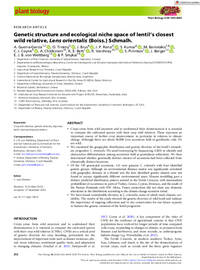Genetic structure and ecological niche space of lentil's closest wild relative, Lens orientalis (Boiss.) Schmalh.

Authors:
Crops arose from wild ancestors and to understand their domestication it is essential to compare the cultivated species with their crop wild relatives. These represent an important source of further crop improvement, in particular in relation to climate change. Although there are about 58,000 Lens accessions held in genebanks, only 1% are wild.
We examined the geographic distribution and genetic diversity of the lentil's immediate progenitor L. orientalis. We used Genotyping by Sequencing (GBS) to identify and characterize differentiation among accessions held at germplasm collections. We then determined whether genetically distinct clusters of accessions had been collected from climatically distinct locations.
Of the 195 genotyped accessions, 124 were genuine L. orientalis with four identified genetic groups. Although an environmental distance matrix was significantly correlated with geographic distance in a Mantel test, the four identified genetic clusters were not found to occupy significantly different environmental space. Maxent modelling gave a distinct predicted distribution pattern centred in the Fertile Crescent, with intermediate probabilities of occurrence in parts of Turkey, Greece, Cyprus, Morocco, and the south of the Iberian Peninsula with NW Africa. Future projections did not show any dramatic alterations in the distribution according to the climate change scenarios tested.
We have found considerable diversity in L. orientalis, some of which track climatic variability. The results of the study showed the genetic diversity of wild lentil and indicate the importance of ongoing collections and in situ conservation for our future capacity to harness the genetic variation of the lentil progenitor.
